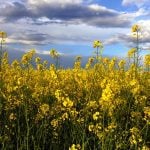Experienced threshing crews gathered at Langenburg, Sask., in August to set a new Guiness Record
Forty two threshing crews from across western Canada and the U.S. gathered at Langenburg, Sask., in late August to help set a new Guiness Record for the number of threshing machines run at one time in one spot. The previous record was 29 threshing machines. The group raised over $60,000 for the Foodgrains Bank. The event was […] Read more



